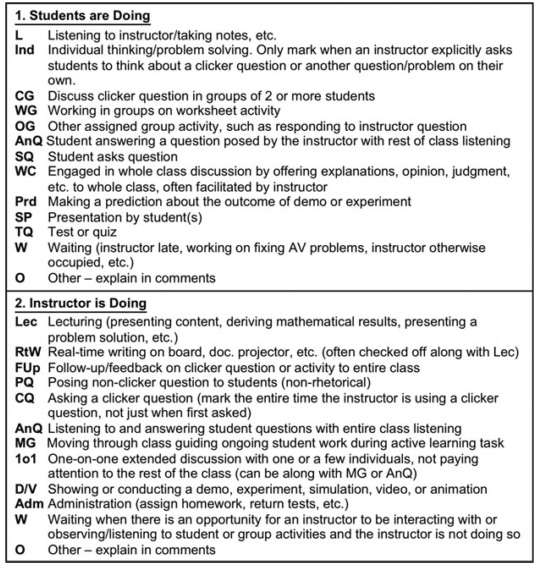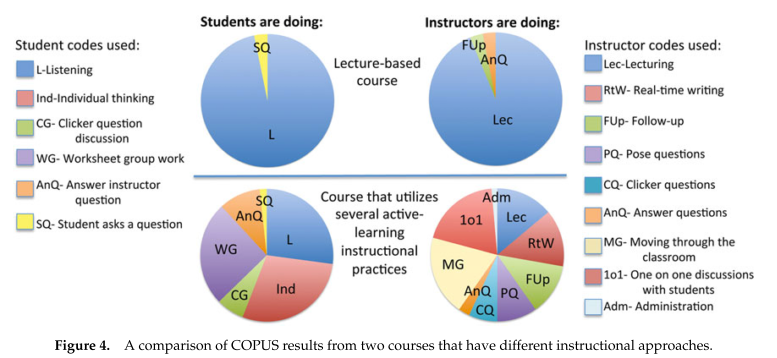Developed by Michelle K. Smith, Francis H. M. Jones, Sarah L. Gilbert, and Carl E. Wieman
| Purpose | To allow observers with little observation protocol training and experience to reliably characterize what both faculty and students are doing in a classroom. |
|---|---|
| Format | Observation protocol |
| Duration | N/A min |
| Focus | Teaching (What are the students doing?, What is the instructor doing?) |
| Level | Upper-level, Intermediate, Intro college |
Descriptions of the COPUS student and instructor codes:

more details
This is the highest level of research validation, corresponding to all seven of the validation categories below.
Research Validation Summary
Based on Research Into:
- Classroom behavior
Studied Using:
- Iterative observations
- Inter-rater reliability
- Training materials
Research Conducted:
- At multiple institutions
- By multiple research groups
- Peer-reviewed publication
The codes on the observational protocol were developed based on iterative modifications of the TDOP observation protocol. Sixteen science education specialists used the preliminary protocol in pairs or trios across most departments at one university. The science education specialists met to discuss coding difficulties, and the COPUS was refined through five versions. The COPUS was then tested with 16 K–12 teachers participating in a teacher professional development program, and the COPUS was revised. The final version was tested by having the same 16 K–12 teachers use it to observe 23 STEM classes, and by having seven STEM faculty observers use it to observe eight classrooms at another university in pairs after 1.5 hours of training. The inter-rater reliability of the observations was was to be good. COPUS results are published in one peer-reviewed publication.
References
- K. Commeford, E. Brewe, and A. Traxler, Characterizing active learning environments in physics using latent profile analysis, Phys. Rev. Phys. Educ. Res. 18 (1), 010113 (2022).
- T. Lund, M. Pilarz, J. Velasco, D. Chakraverty, K. Rosploch, M. Undersander, and M. Stains, The Best of Both Worlds: Building on the COPUS and RTOP Observation Protocols to Easily and Reliably Measure Various Levels of Reformed Instructional Practice, CBE Life. Sci. Educ. 14 (2), (2017).
- M. Smith, F. Jones, S. Gilbert, and C. Wieman, The Classroom Observation Protocol for Undergraduate STEM (COPUS): A New Instrument to Characterize University STEM Classroom Practices, CBE Life. Sci. Educ. 12 (4), 618 (2013).
We don't have any translations of this assessment yet.
If you know of a translation that we don't have yet, or if you would like to translate this assessment, please contact us!
Download the COPUS scoring tool.
| Typical Results |
|---|
Results from the COPUS are only a measure of what is happening in the classroom and not a rating of it. Many of the items on the COPUS are representative of practices that are known to generally be "better" or "worse" methods so the time spent on these items as shown in the COPUS results could show room for improvement. From Smith et al. 2013.
|
The latest version of the COPUS, v1, was released in 2013.




